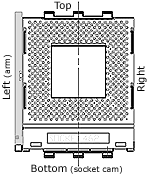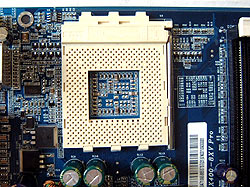| pcstats
heatsink clearance measurements |
| top clearance: |
7 mm |
| bottom (cam) clearance: |
11 mm |
|
| left side (arm) clearance: |
33mm |
| right side clearance |
25 mm |
|
| socket mounting holes: |
n/a |
| max. heatsink base dimensions: |
~101x76 mm |
|
 Note: Approx.
measurements are made from the edge of the socket (not the clips) to
the closest obstacle taller than the ZIF socket
itself. Note: Approx.
measurements are made from the edge of the socket (not the clips) to
the closest obstacle taller than the ZIF socket
itself.
The socket is 51mm across, and 62mm from
top to bottom. | |
 |
The area around the
CPU socket has been cleared pretty well, and larger heatsinks such as the Thermalright SLK-800
or Thermaltake Volcano 7+ should fit just fine. There are no mounting holes on the
motherboard so any heatsink that needs bolt on is not useful.
Overclocking with FSB only
Overclocking the
KX400-8XV Pro was not as much fun as we had had with previous Albatron motherboards because
the board was tuned to a more mainstream audience. With no multiplier controls in the BIOS to tweak out, we were limited
to raising the FSB only, and rather slowly at that. Though I don't want to admit
it, some motherboards are intended to simply power your average everyday joe's computer - and overclocking
isn't always on the menu. Kind of like crispy fries.
With expectations of a modest overclock I started
to increased the FSB speed slowly, 1-2 MHz at a time.
Bang. At 177 MHz FSB we hit the maximum speed.
As an overclocking adventure that is probably the shortest we have ever
seen, but to be honest I think the ATi Radeon 9700 Pro was holding
back the motherboard. A 71MHz AGP clock speed doesn't sound that high (no AGP/PCI locking options) be we did
find a few hard locks would occur when running through 3D oriented benchmarks or programs. Before you
throw your hands up in the air, the board does have some good
tweaking areas in the BIOS as you're about to see...
